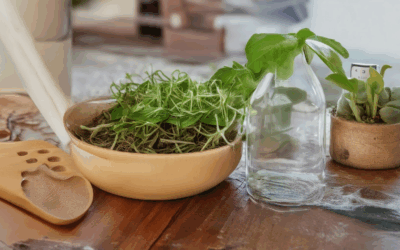In today’s increasingly eco-conscious world, more families are seeking ways to reduce their environmental footprint while maintaining a comfortable and healthy lifestyle. One of the most straightforward ways to make a positive impact is by incorporating eco-friendly family products into your daily routines. From sustainable household items to kid-safe essentials, there’s a wide array of options designed to promote both environmental stewardship and family well-being. This comprehensive guide delves into the best eco-friendly products for every aspect of life, providing practical tips and insights to help you create a greener home. Whether you’re looking to replace everyday items with more sustainable alternatives or embark on a DIY eco-friendly project, this article offers a wealth of information to inspire and inform. By making thoughtful choices, you can not only benefit the planet but also foster a healthier, more mindful lifestyle for your family.
Key Takeaways
- Eco-Friendly Families Commit to Sustainability: By adopting sustainable practices, families can significantly reduce their environmental impact.
- Key Aspects Include Reducing Waste and Conserving Resources: Families can make a difference through recycling, composting, and efficient use of energy and water.
- Sustainable Lifestyles Offer Cost Savings and Well-being: Eco-friendly choices often lead to financial savings and improved health for families.
- DIY Eco-Friendly Products Reduce Waste and Costs: Creating your own products at home minimizes waste and helps families live more sustainably.
- Understanding Green vs. Eco-Friendly Products Is Essential: Knowing the differences can help families make informed choices that benefit the planet.

Examples of Eco-Friendly Products
Eco-friendly products are items that minimize their environmental impact through sustainable materials, energy efficiency, or ethical production practices. Here are some examples:
- Reusable Items: Reusable water bottles, cloth shopping bags, and stainless steel lunch containers.
- Energy-Efficient Appliances: LED light bulbs, smart thermostats, and solar-powered gadgets.
- Sustainable Clothing: Hemp shirts, organic cotton apparel, and second-hand or upcycled clothing.
- Household Products: Non-toxic cleaning supplies, biodegradable laundry detergents, and bamboo-based household items.
- Technology Gadgets: Solar-powered chargers, recycled electronics, and energy-efficient smartphones.
- Food and Agriculture: Organic fruits and vegetables, compostable kitchen scraps, and fair-trade coffee.
- Personal Care: Natural skincare products with essential oils, reusable makeup remover pads, and biodegradable toothbrushes.
Eco Planeta Verde offers a variety of sustainable products and resources to help you adopt eco-friendly practices in your daily life. Explore our collection today and make a positive impact on the environment!
What Are Eco-Friendly Household Cleaning Products?
Eco-friendly household cleaning products are designed to be safer for people, pets, and the environment while effectively performing their cleaning tasks. Unlike traditional cleaners, these products typically use natural, non-toxic, and biodegradable ingredients, minimizing harm to health and reducing pollution.
Choosing eco-friendly cleaning products can help reduce your carbon footprint and promote sustainability. Many of these products are made from renewable resources or derived from plant-based ingredients, making them a responsible choice for homeowners who care about both their families and the planet.
Why Choose Eco-Friendly Cleaning Products?
- Safety for Families: Many conventional cleaning products contain harmful chemicals that can cause respiratory issues, skin irritation, or other health problems. Eco-friendly options are often free from toxic substances, making them safer for children and pets.
- Environmental Impact: Traditional cleaning products can release pollutants into the air and water, contributing to environmental damage. Eco-friendly alternatives are usually biodegradable, reducing their impact on the environment.
- Reduced Plastic Waste: Many eco-friendly cleaning products come in recyclable packaging or are sold in bulk, further reducing waste and promoting a more sustainable lifestyle.
Common Uses for Eco-Friendly Cleaning Products
- Laundry Detergent: Use baking soda, vinegar, or plant-based detergents to clean clothes safely.
- Window Cleaning: Make a solution with water and white vinegar to clean glass effectively without harsh chemicals.
- Kitchen Cleaners: Baking soda is an effective cleaner for countertops and sinks, while essential oils can be used to disinfect surfaces.
- Bath and Shower Cleaners: Combine hydrogen peroxide and baking soda for a gentle yet powerful cleaner.
- Floor Cleaner: Mix water with vinegar or hydrogen peroxide for a safe and effective floor cleaning solution.
How to Choose Eco-Friendly Cleaning Products
- Look for Certifications: Products certified by organizations like USDA Organic or EWG (Environmental Working Group) are a good indication of their safety and eco-friendliness.
- Read Labels Carefully: Check ingredient lists to ensure the product aligns with your values and avoids harmful chemicals.
- Support Sustainable Brands: Companies like Eco Planeta Verde offer high-quality, eco-friendly cleaning products made from natural ingredients.
Eco-friendly cleaning products are a simple yet impactful way to make your home safer and more sustainable. By choosing these products, you contribute to a healthier environment and a cleaner future for generations to come.

Most Eco-Friendly Brands
Eco-conscious consumers are increasingly drawn to brands that prioritize sustainability, ethical practices, and environmental responsibility. Here’s a curated list of some of the most eco-friendly brands leading the charge in creating a better world:
- Eco Planet Verde – A leader in sustainable living, offering resources and tips on eco-friendly practices. Their platform focuses on reducing waste, promoting sustainable products, and encouraging green lifestyles.
- Patagonia – Renowned for its commitment to environmental conservation, Patagonia uses recycled materials and supports environmental causes through its 1% for the Planet initiative.
- Reformation – Known for its stylish yet sustainable fashion, Reformation uses organic materials and innovative manufacturing techniques to minimize its environmental footprint.
- People Tree – A pioneer in fair trade and organic clothing, People Tree works closely with artisans to create eco-friendly and ethically produced garments.
- Mountain Equipment Co-op (MEC) – MEC is committed to sustainability, offering a wide range of eco-friendly outdoor gear made from recycled and renewable materials.
- Thermos – Famous for its insulated products, Thermos now produces eco-friendly drinkware made from stainless steel and BPA-free materials.
- Tommy Hilfiger – Tommy Hilfiger has embraced sustainable fashion, introducing organic cotton shirts and recycled denim jackets as part of its Green Jeans collection.
- ECO by Sonya – Specializing in eco-friendly activewear, ECO by Sonya uses recycled materials and sustainable fabrics to create stylish, functional clothing.
- Seasame & Limes – This brand focuses on upcycling ocean plastics into high-quality accessories and apparel, promoting marine conservation through its initiatives.
- Ben & Jerry’s – While known for ice cream, Ben & Jerry’s leads in sustainable packaging and energy-efficient production practices.
These brands demonstrate a strong commitment to sustainability, from reducing waste and using recycled materials to supporting fair trade and ethical labor practices. By choosing these eco-friendly options, consumers contribute to a healthier planet while enjoying high-quality products.
Learn more about Eco Planet Verde’s sustainable initiatives .

What Does Eco-Friendly Family Mean?
An eco-friendly family is one that prioritizes sustainability and minimizes its environmental impact through daily actions and lifestyle choices. This approach involves making conscious decisions to reduce waste, conserve resources, and adopt practices that benefit the planet.
Key Aspects of an Eco-Friendly Family
- Reducing Waste : Families often reduce waste by recycling, composting organic materials, and avoiding single-use plastics. They may also opt for bulk purchasing to minimize packaging waste.
- Conserving Resources : Eco-friendly families typically conserve water and energy. This includes turning off lights when not needed, shortening shower times, and using water-efficient appliances.
- Sustainable Diet : Many eco-friendly families adopt plant-based diets or reduce meat consumption to lower their carbon footprint. They may also support local farmers and buy organic produce.
- Transportation Choices : Families might choose bicycles, public transport, or carpooling to reduce reliance on fossil fuels and lower greenhouse gas emissions.
- Energy Use : Installing solar panels, using renewable energy sources, and investing in energy-efficient appliances are common practices among eco-friendly families.
- Shopping Habits : They often shop locally, supporting small businesses and buying products made from sustainable materials like recycled goods or biodegradable products.
- Education and Involvement : Eco-friendly families are usually well-informed about environmental issues and involve their children in eco-friendly activities to foster a sense of responsibility.
- Waste Reduction Strategies : Families may use cloth diapers, menstrual products, and reusable items like water bottles and food containers to cut down on disposable waste.
Benefits of Being an Eco-Friendly Family
Living an eco-friendly lifestyle can have a positive impact on both personal health and the environment. Families who adopt sustainable practices often experience cost savings, improved well-being, and a stronger connection to their community.
By taking steps to reduce their ecological footprint, eco-friendly families contribute to a healthier planet for future generations. This commitment can inspire others and create a ripple effect of positive change.
Learn more about sustainable living tips and practices .
How to Make Eco-Friendly Products at Home
Eco-friendly living is more than just a trend—it’s a commitment to sustainability. By creating your own eco-friendly products at home, you can reduce waste, save money, and minimize your carbon footprint. Here are 10 easy DIY ideas to get started:
- Reusable Cloth Masks : Turn old t-shirts or fabric into masks using a sewing machine or needle and thread. Not only are they eco-friendly, but they’re also reusable and customizable.
- Natural Cleaning Solutions : Make your own cleaning products using ingredients like vinegar, baking soda, and essential oils. These alternatives are safe for the environment and your home.
- DIY Air Fresheners : Create your own air fresheners using recycled jars and natural ingredients like citrus peels or lavender flowers. This reduces plastic waste and gives your space a fresh scent.
- Upcycled Jewelry : Transform scrap materials like broken jewelry parts or leather scraps into unique pieces. This not only saves materials but also adds a personal touch to your accessories.
- Herbal Insect Repellents : Mix natural ingredients like peppermint oil or neem oil with a carrier oil to create a safe and effective insect repellent. Store in small glass containers for easy use.
- Zero-Waste Kitchen Essentials : Replace disposable items with reusable options like cloth napkins, beeswax wraps, and stainless steel or bamboo utensils. These items last longer and reduce waste.
- Handmade Paper Products : Use scrap paper or cardboard to create toilet paper rolls, paper towels, or gift wrap. This process uses minimal resources and supports zero-waste living.
- Sustainable Baby Products : Make your own baby wipes, diaper inserts, or burp cloths using organic cotton and mild detergents. This reduces reliance on disposable products and their environmental impact.
- Homemade Cosmetics : Craft your own skincare and haircare products using ingredients like coconut oil, shea butter, and essential oils. These alternatives are gentle on the skin and free from harmful chemicals.
- Compostable Scrubby Sponges : Mold kitchen scraps or newspaper into scruffy sponges using a mold. These sponges are biodegradable and perfect for cleaning tasks.
By trying these DIY projects, you can significantly reduce your household waste and promote a healthier, more sustainable lifestyle. Remember to reuse materials whenever possible and share your creations with others to inspire eco-friendly habits!

What is the difference between green products and eco-friendly products?
The terms “green” and “eco-friendly” are often used interchangeably, but they have distinct meanings and scopes. Here’s a breakdown of the key differences:
| Green Products | Eco-Friendly Products |
|---|---|
| Definition: Products or practices that aim to minimize environmental impact through sustainable methods. | Definition: Products specifically designed to have minimal or zero negative effects on the environment. |
| Scope: Broader concept that includes various aspects of sustainability, such as energy use, transportation, and consumption patterns. | Scope: Focused on the environmental impact of individual products or services, often through resource efficiency and renewable materials. |
| Examples: Renewable energy systems, organic farming, and carbon offset programs. | Examples: Products made from recycled materials, biodegradable packaging, and non-toxic products. |
| Goal: Promote overall environmental health and sustainability. | Goal: Reduce the environmental footprint of specific products or services. |
Both concepts aim to contribute to environmental conservation, but “green” is more holistic, while “eco-friendly” is more product-specific. Choosing eco-friendly products can significantly reduce your personal environmental impact, while supporting green initiatives can lead to broader sustainability efforts.
For more tips on adopting eco-friendly practices, visit our tips section and explore our guide on sustainable living.




0 Comments